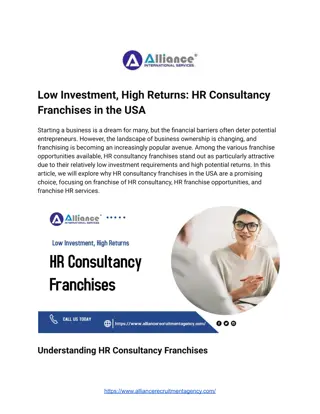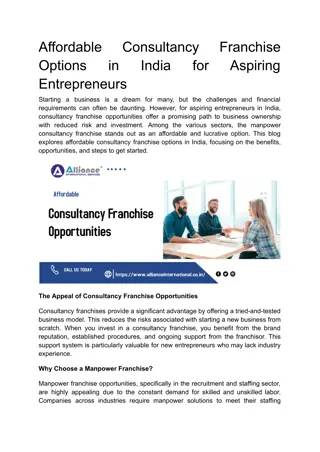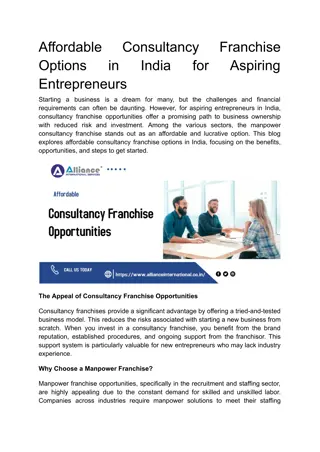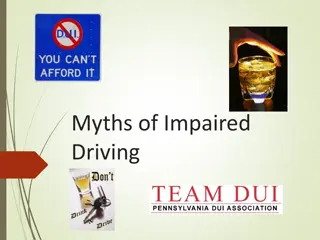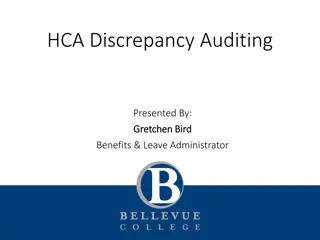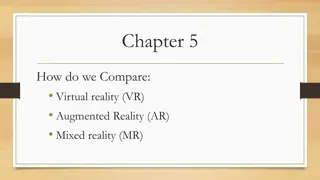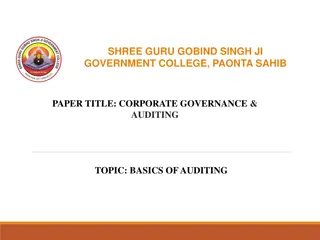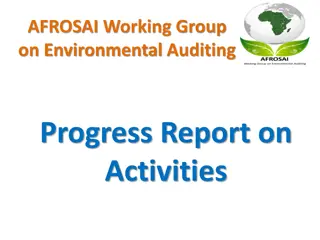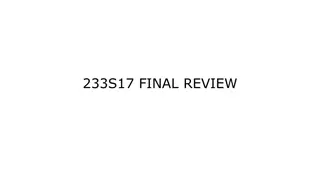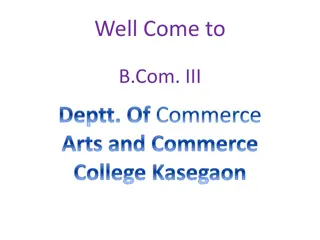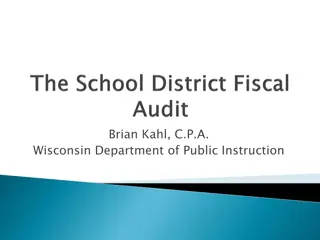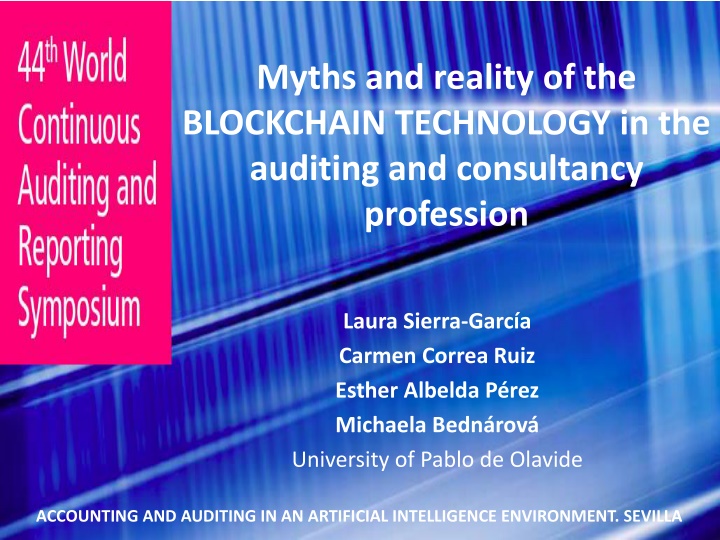
Blockchain Technology in Auditing and Consultancy: Myths vs. Reality
Explore the potential impact of Blockchain Technology in the auditing and consultancy profession, uncovering opportunities and challenges for auditors and consultants. Delve into how BT could enhance efficiency and safety in digital transactions, ultimately transforming industries and market structures. Discover the latest insights from academic and professional realms on leveraging BT for increased transparency, reduced costs, and improved data integrity in auditing practices.
Download Presentation

Please find below an Image/Link to download the presentation.
The content on the website is provided AS IS for your information and personal use only. It may not be sold, licensed, or shared on other websites without obtaining consent from the author. If you encounter any issues during the download, it is possible that the publisher has removed the file from their server.
You are allowed to download the files provided on this website for personal or commercial use, subject to the condition that they are used lawfully. All files are the property of their respective owners.
The content on the website is provided AS IS for your information and personal use only. It may not be sold, licensed, or shared on other websites without obtaining consent from the author.
E N D
Presentation Transcript
Myths and reality of the BLOCKCHAIN TECHNOLOGY in the auditing and consultancy profession Laura Sierra-Garc a Carmen Correa Ruiz Esther Albelda P rez Michaela Bedn rov University of Pablo de Olavide ACCOUNTING AND AUDITING IN AN ARTIFICIAL INTELLIGENCE ENVIRONMENT. SEVILLA
CONTENT INTRODUCTION LITERATURE REVIEW METHOD RESULTS CONCLUSION
INTRODUCTION Today businesses are more complex and internationally connected. New regulations, accounting and auditing standards (Europe Key Audit Matters , 2016; USA Critical Audit Matters , 2020), adding complexity, and increasing the cost of control and reporting for businesses. - a need for efficient solutions Blockchain Technology (BT), a distributed digital ledger, could help business by making digital transactions more efficient and safe. BT has been indicated as game-changing disruptive innovation that has the potential to transform industries and the structure of markets (Deloitte, 2016)
INTRODUCTION OBJECTIVES This research aims to explore the role of Blockchain Technology (BT) in auditing from the perspective of auditors and consultants to identify the real opportunities and challenges emerging from its implementation.
LITERATURE REVIEW Accounting and Auditing Academia. Professional Firms. Professional Bodies.
LITERATURE REVIEW Accounting and Auditing Academia. o Increase transparency and auditability o Reduce auditing cost, human errors, and fraud. o Ensure data integrity (Rozario and Vasarhelyi, 2018). o Facilitate real-time supervision to reduce auditing risk. o Continuous Accounting and Auditing (Dai and Vasarhelyi, 2017) o Auditors more IT than accounting oriented and become more forward than backward-looking. The profile of the auditors will change. o More sceptical point of view (Coyne and McMickle, 2017) and enable automated auditing
LITERATURE REVIEW Professional Firms: Audit firms Initiatives. o EY: Building tools to help companies identify risks in the Blockchain. Libra, which is a distributed ledger focused start-up. o Deloitte: Focusing on the implementation of Blockchain technology. Rubix software platform where customers of the company can design their own smart contracts and other applications. o KPMG: Auditing, taxing and analyzing Blockchain integration. KPMG's Digital Ledger Services in collaboration with Microsoft. o PWC: Investment in VeChain, is building supply chain of the future. 1,000 staff in the Blockchain. technical development and
LITERATURE REVIEW Professional Firms: Audit firms Documents. o EY (2017); Deloitte (2016); KPMG (2018); PWC (2018): 1) The way businesses are audited will clearly change. 2) Standardization would allow auditors to verify a large portion of the most important data behind the financial statements automatically. 3) Greater focus on more complex transactions and internal controls, fundamentally changing the scope and approach of an audit opinion. 4) Role of auditor would change, who would focus on confirming in conjunction with accounting standards rather than auditing transactions.
LITERATURE REVIEW Professional Firms: Audit firms Documents. 5) Audit teams expertise and technologies required 6) Auditors would involve in reviewing the technology s implementation, assessing the quality of incoming and outgoing data, and identifying cybersecurity-related risks. 7) Change of collecting audit evidence. 8) Audit operating costs would be reduced. 9) New audit strategy: continuous and real-time auditing.
LITERATURE REVIEW Professional Firms: Certifier firms Initiatives. o SGS: Komgo will launch a new Blockchain-based platform before the end of the year that will transform commodity trade finance by enhancing efficiency and strengthening security. o BUREAU VERITAS: Origin is based on an easy Blockchain system, which is open, transparent, secured, and operates without central controlling device. With the Blockchain technology, the full lifecycle of the product can be digitally replicated and shared among the different players.
LITERATURE REVIEW Professional Bodies. o American Institute of Certified Public Accountants (AICPA). impact all recordkeeping processes, including the way transactions are initiated, processed, authorized, recorded and reported. Changes in business models and business processes may impact back-office activities such as financial reporting and tax preparation. o Institute of Chartered Accountants in England and Wales (ICAEW): more efficiently and have lower operating costs. But the rewards are trustworthy records and reduced reconciliations. Accountants skills will need to expand. Auditors and regulators with access would be able to check transactions in real time.
LITERATURE REVIEW Professional Bodies. o Association of Chartered Certified Accountants (ACCA) Blockchain help audit: Immutability, sampling, timing, and true and fair view
METHODS PILOT STUDY Phase 1: Semi-structured interviews (Auditors). Phase 2: Semi-structured interviews (Certifiers). Phase 3: Focus group: Auditors/Certifiers/Companies.
METHODS Identifying three building blocks Opportunities and Challenges Role of BC Implementation and Impact
METHODS The role of Blockchain Technology and extent of knowledge. 1. Are there currently initiatives related to Blockchain technology (projects / training / working groups) in your organization? 2. How would you describe the role of Blockchain technology in the current context? 3. How would you evaluate your level of knowledge of Blockchain technology?
METHODS Opportunities and challenges of Blockchain Technology for audit function. 4. What opportunities do you think BT can offer to companies in general? And in relation to the audit processes? 5. What challenges does BT entail in general? And in relation to the audit processes? 6. How can BT affect the collection of evidence, the audit tests and the work methodology employed by the auditors? 7. To what extent are audit professionals prepared for the adaptation suggested by BT? How should the auditor's training curriculum be changed to meet the challenges of this technology?
METHODS Implementation of the Blockchain Technology and impact on the markets. 8. How do you think the regulators of financial markets will respond to BT? 9. Although many of the benefits of this technology have been revealed, limitations and ethical issues that must be considered have also been pointed out. What can you say about it? 10. When do you think BT will be implemented effectively and Blockchain-based continuous audit would be fully performed in organizations?
METHODS Identify the objectives Identify participants Indentify location Research Design Data Pre-session preparation Facilitation during meeting Collection Discourse analysis Conversation analysis Analysis Results and Reporting
RESULTS The role of Blockchain Technology and extent of knowledge. o Regarding the current BT initiatives, there are some initiatives, but mainly in advisory department so a common auditor is not in touch with them. o BT is generally perceived as a hot topic, but some auditors also connect it with investment. Others consider BC too complex for general use with very low benefits publicly presented. o The level of knowledge is generally very low and so far they even seem to be reluctant to engage with this technology in their daily routine as auditors. At this moment, they kind of can t imagine how it will be designed to work properly. a database for speculative
RESULTS Opportunities and challenges of Blockchain Technology for audit function. o Opportunities: cybersecurity, improved information quality and legitimacy of transaction, decrease the fraud risk, improve the control processes. o Challenges: not every company might be willing to adopt this technology, the need of involvement of IT auditors and developers, hard to collect the documentation. o Collection of evidence: easy access, much safer and faster, higher efficiency, lower risks of human errors. o Auditor's training curriculum: not focusing on blockchain, will be huge initiatives and trainings, on the general understanding of this technology.
RESULTS Implementation of the Blockchain Technology and impact on the markets. o Regulators of financial markets: transformed to IT Audit , no soon due to complexity of understanding, harder for state regulators. o Limitations and ethical issues: ethical issues will be revealed late. o Implementation and continuous auditing not believe in a close future, need a significant reengineering of AISs and related methodology, significant cost for auditing.
CONCLUSION The effect of Blockchain Technology on the profession is not fully anticipated and smaller auditing firms Skills of Auditors will change (more IT oriented and more forward-looking). Are they prepared? Collection of evidence will be faster, safer, more efficient, with lower risks of human errors. Harder for state regulators. Are regulators adapted? Implementation and continuous auditing not expected in a close future.
CONCLUSION Internal challenges Technological aspects (appropriate BC design and architecture, smart contracts solutions, etc.) New skill set of auditors needed (IT skills) Smooth transition To facilitate a smooth transition might be the most challenging task. Training will play an important role. Training: Demand (new skills are needed IT skill set) Mind set (understanding of technology and its benefits) Technology acceptance corporate culture will play an important role
CONCLUSION External challenges Stages of technology adoption We might enter into a limbo where technology would advance faster than regulators` consensus



